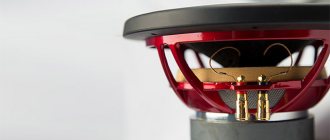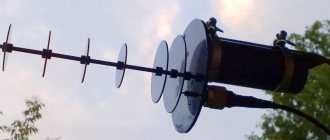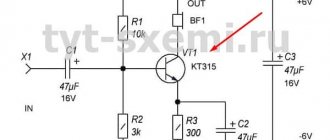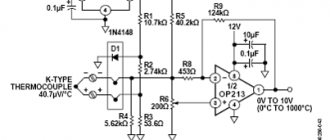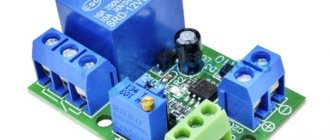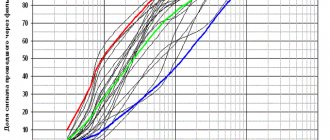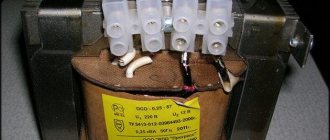Connection diagram
Connecting the amplifier begins with laying the power cables and the control cord leading to the head speaker unit. For power supply, a copper cable with insulation that does not deteriorate when exposed to negative temperatures is used. The wiring is routed under the floor and sill trims, and then routed to the battery installation location (under the hood or in the luggage compartment). It is recommended to connect the negative and positive power cables to the battery. Additionally, a capacitor is provided in the circuit to smooth out voltage drops.
The positive cable is equipped with a special fuse located at a distance of 400-500 mm from the battery terminal. The rating of the insert depends on the parameters of the standard protective devices located in the amplifier block. For example, when using a fuse rated for a current of 40 A in an amplifier, the rating of the protective unit in the power circuit should not exceed 50 A. Metal crimped tubes or soldering are used to connect electrical wiring components; twisted wires do not provide unreliable contact and are susceptible to oxidation.
Then the user connects a special cord to the 4-channel amplifier to synchronize the turn-on, coming from the radio (with blue insulation). When the audio device is turned on, a low-voltage signal is supplied through the cord to the amplifier's power supply. After turning on the additional equipment, sound broadcasting through the speakers begins. The amplification equipment is equipped with a control LED that allows you to visually check the functionality of the power circuits.
Are you a car driver?! Then you can take this simple test and find out. Go to test »
The player, equipped with linear outputs, is connected to the amplifier unit with special acoustic wires with a metal screen that reduces sound distortion due to exposure to electromagnetic fields. For a radio without linear ports, use a special adapter connected to standard speaker outputs.
It is recommended to lay speaker cables away from electrical motors, circuits or components of the ignition system or electronic components that are a source of interference. When running cords, it is not allowed to press the insulator against the metal edges of the body panels, which can cut the protective layer. When switching the amplifier module, the correct connection of the channels is monitored; if the cross-connection is incorrect, you will have to switch the signal cables in the correct sequence.
Speaker cables are connected to the 4 speakers (factory wiring can be used), which are led out to the installation site of the amplifier unit. The unit is located in the free space under the passenger seat, on a special pedestal in the luggage compartment or on a suspension under the rear acoustic shelf. The cords are laid under the soundproofing of the cabin floor. It is possible to connect 8 speakers, which are connected in pairs (in parallel or in series).
When connecting loudspeakers to an amplification device, the polarity of the connection must be observed. The negative terminals of the speakers are connected to the negative contacts of the corresponding channel; it is prohibited to combine the cables into a common line with a connection to the ground (car body). If connected incorrectly, the loudspeakers broadcast the signal out of tune, disrupting the uniform distribution of sound in the car interior. When connecting a subwoofer to a 4-channel amplifier, it is necessary to make adjustments to the switching circuits.
What you will need
Before starting installation, you need to prepare the following materials:
- insulating tape;
- metal tubes for connecting cords;
- switching parts for connecting to vehicle electrical circuits;
- acoustic and electrical cords with clamps;
- fasteners for brackets.
The list of additional equipment expected to be installed depends on the financial capabilities and preferences of the owner. It is important to remember that the further operation of the acoustics depends on the characteristics of the amplifier. For example, if you connect a sub to a 2-channel amplifier, you will need to cut the playback frequency range for 2 channels. In this case, it is recommended to install a 4-channel unit using the rear outputs to bridge the subwoofer.
Tools
To install the equipment and connect connecting cords, you will need the following tools and materials:
Are you a car driver?! Then you can take this simple test and find out. Go to test »
- side cutters for cutting cables and removing insulation;
- screwdrivers and wrenches for dismantling plastic casings;
- connecting clamps;
- test device for checking the integrity of power circuits;
- additional terminals and tool for installing lugs.
How to choose a wire cross-section
Since the external amplifier consumes current up to 40-50 A (depending on the modification), it is necessary to select a suitable power cable for connection. To calculate the cross-section, you will need to find out the rated power of the equipment, which is indicated in the operating instructions and on the factory label. The total energy consumption is equal to the product of power and the number of channels involved. For example, when a 50 W signal is supplied to 1 loudspeaker, the total consumption for 4 channels will be 200 W.
Then you need to calculate the length of the cord going to the battery. Based on the obtained figures, a multi-core copper cable with the required cross-section is selected from the table. It is recommended to take a wire with a margin of 10-15%, which will allow you to safely connect the amplifier in the car. It is not recommended to use aluminum strands or elements with a copper-plated surface.
To connect acoustic components, interconnect cables supplied with the products are used. To improve sound quality, it is recommended to purchase improved cords equipped with high-quality switching elements. The connecting speaker cables have a standard design, differing only in the quality of the materials used.
Fuse selection
The fuse protects the vehicle's electrical wiring and amplifier from damage due to short circuits or increased current due to overload. The element is installed in the positive connection wire near the battery terminal. The rating of the insert is determined based on tables taking into account the cable length and cross-sectional area. Additional automotive-type fusible links (knife) are located in the housing of the amplifier unit.
How to connect a subwoofer
The low-frequency loudspeaker is connected by a bridge to the outputs for rear speakers. The negative cable is connected to the negative terminal of one output, and the positive signal comes from the positive terminal of the opposite channel. Front channels are used to connect the remaining speakers, which are connected in parallel or in series. The connection diagram depends on the resistance rating of the coils and the characteristics of the amplifier unit.
In the connection circuit of a 4-channel amplifier and subwoofer, it is possible to introduce an additional low-frequency speaker (with identical characteristics), which is switched by a bridge to the front channels. In this case, an additional amplifier unit is introduced into the car's acoustic system, servicing loudspeakers that reproduce medium and high frequencies.
External amplifiers are designed to increase the volume and quality of sound transmitted by the radio. A bridged 4-channel amplifier is designed to connect external speakers and a subwoofer for maximum sound power. The design of the amplifier allows you to configure the harmonious parameters of the combined sound of standard loudspeakers and a subwoofer.
Two-channel amplifier for subwoofer - installation and connection diagram
Two-channel amplifier for a subwoofer - installing a subwoofer in a car definitely guarantees an increase in the sound quality of the speaker system, although this largely depends on its proper connection to the power amplifier. But, like all work with radio-electronic devices, it is not as simple as some amateurs believe. Firstly, you need to take into account a whole range of significant parameters that will ensure the correct and reliable operation of the equipment. In this article we want to share many years of experience in installing audio systems in cars.
Before starting installation work, it would be advisable to compare the RMS values of the amplifier and subwoofer. That is, the power at which the equipment can easily operate with an audio signal for about an hour without any problems. When comparing radio equipment, whether it is a two-channel amplifier for a subwoofer or a four-channel one, it doesn’t matter, it should be so that this particular value of the amplifier is slightly larger relative to the subwoofer. Otherwise, unwanted peak power may occur that is significantly higher than the rated level. It is during clip-on power surges that expensive acoustics most often fail.
Connection diagram
The connection diagram for a 4-channel amplifier requires reliable power supply, which is supplied from the positive terminal of the battery. The cables are connected through a fuse insert; the rating of the protective element is 5-10% higher than the ratings of the factory fuses in the amplifier housing. The cable cross-section is selected according to the table depending on the power consumption. When using a thin cable, overheating and destruction of the insulation occurs, leading to a short circuit and ignition of the structure or vehicle.
The negative signal is supplied through a connection to the ground bolt welded to the car body panels. A lug is put on the cable, which is then pressed with a nut. On used domestically produced cars, it is recommended to remove power from the negative terminal of the battery, since corrosion on the surface of the bolt increases the contact resistance and degrades the power supply to the equipment.
To automatically turn on the amplifier, a copper cable (with a cross-section of up to 1 mm²) is used, coming from the REM connector of the head unit. After turning on the radio, a control signal is supplied to the amplifier, activating the power circuits. To transmit the audio signal, RCA standard cables are used, equipped with a screen to protect against interference. Special metal tips are placed on the ends of the cords to ensure reliable contact. Interconnect cables must not be laid near power wiring due to interference.
Are you a car driver?! Then you can take this simple test and find out. Go to test »
The head unit is equipped with a separate power circuit; a red-insulated cable is routed through the ignition switch or switch, which forcibly breaks the circuit. The radio's power supply is provided with an additional cable equipped with a yellow protective layer.
The cord is connected to the positive terminal of the battery, which ensures the maintenance of the built-in memory in the radio (for storing settings or frequencies of radio stations).
It is possible to use an active subwoofer, which is connected to the linear output on the radio. The second linear channel is used for switching an external amplifier module; a Y-type splitter is used for connection. The transmitted signal is automatically divided by the microprocessor control unit into 4 channels (2 rear and 2 front).
A 1-channel amplifier is designed to switch a low-frequency speaker; by reducing the number of outputs, the power of the equipment is increased. The products allow you to connect subwoofers with a resistance below 4 Ohms; the design includes frequency filters with manual adjustment. It is possible to connect a 1-channel amplifier together with a 4-channel device.
4 speakers and 4 channel amplifier
To connect 4 speakers to an amplifier, you need to route the cables coming from the speakers to the installation location for additional equipment. From each loudspeaker there are 2 cords used to transmit a positive and negative signal. The cables are connected to the corresponding terminals of the front and rear channels. During installation, it is important not to confuse the location of the speaker and the type of channel; if installed incorrectly, a blurred sound picture will be formed.
It is allowed to connect 4 loudspeakers to the front channels; the elements are connected in a parallel circuit in pairs. The output connects to a chain of speakers located on the left or right side of the car. Before making connections, you must make sure that the amplifier unit can be operated with a load of 2 Ohms per channel. The remaining rear channels are intended for bridging a subwoofer.
Another way to use a 4-channel device is to use each channel to connect a pair of speakers with a total impedance of 2 ohms. The scheme allows you to install 8 speakers in the car, which are mounted in the doors, dashboard and shelf under the rear window.
4 speakers and 2 channel amplifier
It is possible to connect 4 speakers located in the front and rear of the car to a 2-channel amplifier. The optimal scheme is to connect the rear speakers through the amplifier unit, while the front speakers are connected to the head unit. On some cars, reverse switching is recommended; the decision is made by the owner based on an analysis of the sound picture in the vehicle interior.
It is possible to cross a pair of speakers on the right and left sides into a parallel circuit, which is routed to the output of the amplifier unit. When switching, the total resistance of the loudspeaker coils and the technical characteristics of the equipment should be taken into account. When switching speakers with reduced resistance, the load on the electronic elements of the amplifier unit increases, which leads to damage to the two-channel device.
2 speakers and 4 channel amplifier
Another configuration for connecting a 4-channel amplifier includes 2 front speakers and a subwoofer, which is bridged to the remaining outputs to the rear speakers. To reduce the load on the electronics, it is recommended to use a speaker equipped with an 8 ohm coil. When the equipment is operating, there is a decrease in sound volume while simultaneously improving quality (due to reduced noise and signal distortion).
The negative signal to the subwoofer is taken from one rear output, and the positive signal from the other. When making connections, check the polarity; a connection error will damage the components. The control signal cable is routed from the Rem plug to the radio. It is allowed to use 2 subwoofers in a car, connected by a bridge to the front and rear outputs, respectively. There are dual-coil woofers that are also designed to be bridged across the front and rear channels.
Daisy chaining of speakers
A daisy chain connection is when they are switched on one after the other, like carriages. If you look at the diagram, the wires are connected like this. We feed the minus from the output of the amplifier to the minus of speakers A, and the plus to the plus of loudspeaker B. And we connect their free inputs (plus at A and minus at B) to each other.
Connecting speakers in series: resistance adds up, output power drops
Please note that the impedance of the speaker chain increases. It is summed up from all components. In the example, two 2 Ohm speakers are connected in series. The total resistance is already 4 Ohms. This connection is good if the amplifier cannot operate with a low-impedance load. Low resistance is 2 ohms and below. In this case, either speakers with a higher resistance are connected, or low-impedance ones are connected in series.
How to connect three or more speakers in series
How to connect three speakers in series to one channel? Yes, everything is the same - one by one. Minus, apply to minus first (A); plus - to the plus of the third C (or last). We connect the free plus from element A to the minus of element B. Then we feed plus B to minus C. So we get a chain of three speakers connected to one channel.
How to connect 3 speakers to 1 channel in series
If you need to connect four or more fragments in series to one channel, simply insert them in the middle. Don't forget that circuit resistance adds up. With each new element in the chain it becomes larger.
Power in series connection
As the resistance increases, the output power will drop. How many watts will each speaker receive when connected in series? And you can count. There is a formula - it is in the picture.
Input power is the power that the amplifier will put into the channel, that is, what we are trying to calculate. The measured power is that indicated in the characteristics (what goes into the channel according to the passport data). And Zr is the resistance at which the power was measured. It is usually written in the characteristics as the minimum load on the channel. And the total resistance is the resistance of the speakers that you plan to “hang” on this channel.
Formula for calculating the actual power supplied to the amplifier channel
Let's apply the formula with an example. Let us have a 2-channel amplifier that outputs 100 W (2*100 W) to each channel. It cannot work with low-resistance loads (2 Ohms and below). Therefore, it was decided to connect two speakers with a resistance of 2 Ohms in series for each channel. We substitute the data into the formula: 100 W * (4 Ohm / 8 Ohm) = 100 W * 0.5 = 50 W. This is what will go into each channel.
The power of the speakers must be selected so that it is 10-20% higher than the power that will be received by it. In this case, any loudspeaker will work for a long time. And if you take the power “back to back”, then even the highest quality speaker will very soon wheeze and will need to be replaced .
Since there will be two loudspeakers on the channel with the same parameters, the channel power will be divided in half. So we get that each speaker will receive 25 watts. If you add the desired power reserve, you will have to look for speakers with a power of at least 30-35 W.
Setup Instructions
The amplifier is configured in accordance with the recommendations set out in the operating instructions. To adjust the parameters, buttons and rotary switches are used, covered with a protective panel. Rotating correctors are recessed into the body, which reduces the likelihood of accidental position changes. To rotate the element, it is recommended to use a flat blade screwdriver.
A control diode of the power supply is installed on the equipment case; further adjustment of the device is allowed only when the green lamp is turned on. When using standard factory settings of the equipment, the sound picture is blurry. Adjusting the parameters allows you to highlight low and high frequencies, as well as reduce sound distortion.
Amplifier setup for four speakers without subwoofer
After completing the connection of the four-channel amplifier and checking the operation of the electrical circuits, you need to configure the acoustics according to the following method:
- Turn the knob labeled Gain or Level to its minimum position.
- When using standard door speakers, you need to turn the HP filter control to the maximum position (indicated on the body as Full). If the car has small-sized acoustics with a diameter of up to 100 mm (in the instrument panel or front pillars), then it is necessary to set the corrector to the position corresponding to 120 Hz.
- Turn off the bass boost function and turn off the graphic equalizer.
- If you connected a 4-channel amplifier with channel separation, then you need to activate the HP and LP filters (for high-frequency speakers and mid-range speakers, respectively). The controls are set to the position corresponding to 4 kHz.
- The design of the amplifier unit has a HiLow Level switch, the position of which depends on the type of connection of the equipment to the head unit. When a signal is fed through speaker cords, the Hi position is set. If you connect the equipment to the linear outputs of the radio, the switch is moved to the Low position.
- Turn on the head unit, which contains a laser disc with musical compositions; you can install a removable drive with recordings in MP3 format (with a high bitrate). Check the position of the loudness selector (should be off), and then smoothly turn the volume control until wheezing appears in the sound picture. Carefully turn the corrector back, determining the boundary of the appearance of interference.
- Then the user adjusts the position of the Gain or Level control, the adjustment is made in the same way as adjusting the sound volume.
- Determine the broadcast volume for the rear channels, comparing the settings with the parameters of the front speakers. If the car owner has difficulty adjusting the acoustic equipment, it is recommended to contact a specialized service center.
Setting up an amplifier for a subwoofer and speakers
The adjustment is made by analogy with the adjustment of a system with standard acoustics. To ensure an improved sound picture, it is recommended to relieve the speakers from broadcasting low frequencies. This action allows the diffuser stroke to be reduced and improves the reproduction of mid frequencies. The HPF corrector is used for adjustment; the position of the potentiometer is determined by the user by ear. Some car owners do not turn on the HPF adjustment due to distortion of the sound picture.
The use of bass boost for a subwoofer is not recommended since it affects the band above 40 Hz. When using a subwoofer with a bass reflex, the subsonic filter is turned on, which is adjusted to a frequency 2-5 Hz below the bass reflex value (indicated on the equipment).
Many car owners without technical education do not know how to connect an amplifier to a car radio - for them it seems like too much of a time-consuming task. In fact, you shouldn’t rush to contact a car service center, since installing a car amplifier is not so difficult.
Maintenance by specialists will be expensive, so in order to save money, it is worth trying to understand the connection procedure, which this article will help with.
For high-quality operation of the amplifier you need:
- Give him good food;
- Give a signal from the radio. We looked at how to properly connect the radio here;
- Connect speakers or subwoofer.
More details on how to connect the amplifier can be found below.
Good nutrition is the key to success
The amplifier connection procedure begins with the power wires. Wiring is the most important element of a car audio system; the volume and sound quality depend on it. Amplifiers need a stable power supply, otherwise the power will not be enough and the sound will become distorted. To understand why you need to pay attention to the quality of wiring and how it affects the sound reproduced by a loudspeaker, you need to know what a music signal is.
Some suggest that it represents a sine wave, however, the musical sinhala is characterized by a large difference between the normal and peak value. If sharp signal bursts are not important for car speakers, then in the case of an amplifier the situation is completely different. If the signal exceeds the permissible power for even a second (or even a millisecond), then these “anomalies” will be audible even to those who cannot boast of a good ear for music.
If the car amplifier is connected properly, the signal will flow through the wires undistorted. Carelessly done work or incorrectly selected wire cross-section will result in the sound being more compressed, rough and sluggish. In some cases, wheezing may also be clearly audible.
How to choose a wire cross-section?
Wire is the most common metal with a certain level of resistance. The thicker the wire, the lower the resistance of the wire. To avoid sound distortion during large voltage fluctuations (for example, when playing powerful bass), you must install the correct gauge wire.
It is worth noting that the cross-section of the positive cable should not be larger than the negative one (the length does not matter).
An amplifier is considered to be a rather electrically intensive device. For its effective operation, high-quality grounding is necessary so that it is possible to receive the necessary energy from the battery. To choose the correct wire cross-section, you need to make some calculations. First, look at the instructions for the amplifier (or directly at the box from the manufacturer, if there is no documentation, use the Internet) and find the rated power value (RMS) there. Rated power is the signal power an amplifier can deliver over an extended period of time to one channel of 4 ohms.
If we consider four-channel amplifiers, they usually have a power of 40 to 150 watts per channel. Let's say that the amplifier you purchased produces 80 watts of power. As a result of simple mathematical operations, we find out that the total power of the amplifier is 320 W. Those. How did we calculate this? It’s very simple to multiply the rated power by the number of channels. If we have a two-channel amplifier with a rated power (RMS) of 60 W, then the total will be 120 W.
After you calculate the power, it is advisable to also determine the length of the wire from the battery to your amplifier and you can safely use the table to select the required wire cross-section. How to use the table? On the left side the power of your amplifier is indicated, on the right you select the length of the wire, go up and find out what cross-section you need.
The table shows the cross-sections of copper wires, remember that a large number of sold wires are made of aluminum coated with copper, these wires are not durable and have more resistance, we recommend using current copper wires.
Fuse selection
In order to secure the connection of the car amplifier, it is necessary to protect the power supply from the battery to the amplifier using a fuse. Fuses should be placed as close to the battery as possible. It is important to distinguish between a fuse that protects the device itself (whether it is an amplifier or a radio) and a fuse installed on the power wire.
The latter is needed in order to protect the cable itself, since a considerable current flows through it. Make sure that the fuse ratings match, since if the wiring fuse rating is too large, the wire may burn out as a result of a short circuit. If the rating, on the contrary, is less, then the fuse can easily burn out at the time of peak loads and then there will be no other choice but to buy a new one. The table below shows the wire cross-section and the required fuse rating.
How to connect an amplifier to speakers
If passive speakers are used to output sound from a TV or computer, the system must have a special power amplifier.
To carry out the connection procedure, the number of channels does not matter - both stereo and 5.1 or 7.1 systems are connected in completely the same way. The amplifier is used in passive sound output systems, the speakers of which do not have built-in amplifiers in their design. Without a third-party amplifier, in this case, the sound quality will deteriorate, and due to a mismatch between the speaker impedances and the microcircuit that reproduces sound files, the sound card in the device may burn out.
Standard amplifiers are designed for stereo systems consisting of two speakers or two speakers and a subwoofer. They are connected to the amplifier by connecting it to the speakers using two RCA audio cables. If you need to amplify the sound to play it in 5.1 or 7.1 systems, you will need to combine several amplifiers into a single system or use an AV receiver.
Connecting interconnect wires and control (REM)
To lay the cable, you need to find the linear output on the radio. The linear output can be recognized by the characteristic “bells” that are located on the rear panel of the radio. The number of linear outputs differs in different radio models. Usually there are from one to three pairs. Basically they are distributed as follows: 1 pair - you can connect a subwoofer or 2 speakers (labeled as SWF) If there are 2 pairs of them, you can connect 4 speakers or a subwoofer and 2 speakers (outputs are labeled F and SW), and when there are 3 pairs of linear wires on the radio, you can connect 4 speakers and a subwoofer (F, R, SW) F This is Front i.e. front speakers, R Read rear speakers, and SW Sabwoorer I think it’s clear to everyone what that is.
The connection will require an interconnect wire, which should never be skimped on. It is prohibited to lay the interconnect cable near the power wires, as various types of noise will be heard when the engine is running. You can run the wires both under the floor mats and under the ceiling. The latter option is especially relevant for modern cars, in the interior of which there are electronic accessories that create interference.
You also need to connect the control wire (REM). As a rule, it comes with interblock wires, but it happens that it is not there, purchase it separately; it does not need to be of a large cross-section - 1 mm2 is quite enough. This wire serves as a control for turning on the amplifier, i.e. when you turn off the radio, it automatically turns on your amplifier or subwoofer. As a rule, this wire on the radio is blue with a white stripe; if it is not there, use a blue wire. It is connected to the amplifier to a terminal called REM.
Amplifier connection diagram
Connecting a two-channel and four-channel amplifier
We have combined this section because these amplifiers have a very similar connection diagram, one might even say more simply, a four-channel amplifier is two two-channel ones. We will not consider connecting a two-channel amplifier, but if you figure out how to connect a four-channel amplifier, then you will not have any problems connecting a two-channel amplifier. Most car enthusiasts choose this option for their installations, since this amplifier can connect 4 speakers, or 2 speakers and a subwoofer. Let's look at connecting a four-channel amplifier using the first and second options.
Connecting a 4-channel amplifier to a battery is recommended using a thick cable. How to choose the right power wires and connect the interconnects, we discussed all this above. Amplifier connections are usually indicated in the manufacturer's instructions. When an amplifier is connected to an acoustic system, it operates in stereo mode; in this mode, this type of amplifier can operate under a load of 4 to 2 ohms. Below is a diagram of connecting a four-channel amplifier to speakers.
Now let's look at the second option, when speakers and a subwoofer are connected to a four-channel amplifier. In this case, the amplifier operates in mono mode, it takes voltage from two channels at once, so try to select a subwoofer with a resistance of 4 ohms, this will save the amplifier from overheating and going into protection. Connecting a subwoofer will not be a problem; as a rule, the manufacturer indicates on the amplifier where to get the plus to connect the subwoofer, and where to get the minus. Take a look at the diagram of how to bridge a 4-channel amplifier.
Connecting a monoblock (Single channel amplifier)
Single-channel amplifiers are used for only one purpose - connecting to a subwoofer. A notable characteristic of amplifiers of this type is increased power. Monoblocks are also capable of operating with resistances below 4 ohms, which is called a low-impedance load. Monoblocks are classified as class D amplifiers, and they have a special filter for cutting frequencies.
Installing a single-channel amplifier will not require much effort, since its connection diagrams are very simple. There are only two outputs - “plus” and “minus”, and if the speaker has only one coil, then you just need to connect it to it. If we are talking about connecting two speakers, then they can be connected either in parallel or in series. Of course, you don’t have to limit yourself to just two speakers, but before you connect the amplifier and subwoofer to the radio, will the latter cope with a high level of resistance?
How to connect
If you expect to be told to connect only in parallel or only in series, you are in vain. The connection diagram is selected individually. There are two main points to take into account:
Implementation of parallel connection
If you have an amplifier of a certain power and there are speakers suitable for it, this is good. But it happens that for the amplifier you need to select a load from several available speakers of different power. This is where you need to understand how to connect speakers in series, parallel or mixed so as not to exceed the parameters.
How to connect speakers - in series or in parallel? And so and so. Depends on what speakers you have. Or rather, with what power and resistance. What is also important is the output power of the channel and how many speakers you want to “hang” on each channel.
Determine the power and resistance of the speakers
It’s quite simple here, but we’ll still give a few examples. These markings are usually marked on the back of the case or basket. The photo shows the parameters of the speakers.
Designation of power and resistance on the speaker
Typically, long-term power is indicated, that is, the value at which the dynamic head is able to operate for a long time. At the same time, MAX POWER is indicated on the ALPHARD head - maximum power. This is peak power, its speaker can withstand, for example, a second.
On old domestic speakers the designations are slightly different. For example, in the figure below 2GDSH-3.
Designations on Soviet speakers
The first digit indicates the power of the product. Further, the head is dynamic broadband and its resistance is 8 ohms. So, we’ve sorted out some parameters, let’s move on.
Correct speaker connections
The peculiarity of connecting speakers is that they have positive and negative inputs. They need to be somehow connected to the inputs of the amplifier, and also somehow connected to each other.
Proper parallel and series connection of speakers
